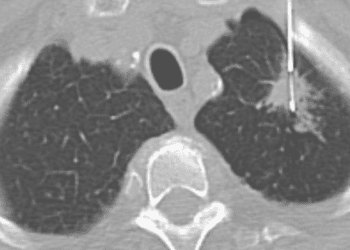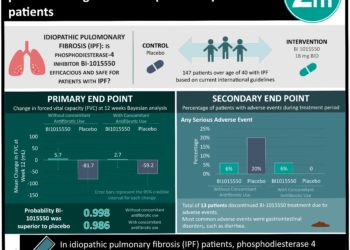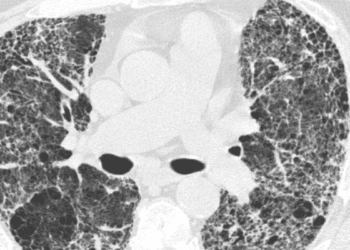Novel imaging agent could enable pulmonary fibrosis diagnosis and monitoring [PreClinical]
1. A gallium-labeled, collagen-binding peptide (68Ga-CBP8) specifically identified fibrotic tissue via positron emission tomography (PET) imaging in two mouse models of idiopathic pulmonary fibrosis (IPF).
2. Changes in 68Ga-CBP8 uptake by fibrotic lungs reflected diminished disease progression in mice treated with an antifibrotic therapeutic, thereby demonstrating the potential utility of 68Ga-CBP8 for noninvasive treatment monitoring.
Evidence Rating Level: 2 (Good)
Study Rundown: Because biopsy procedures for diagnosing IPF are risky and invasive, improved imaging techniques to detect and monitor fibrosis progression are needed. In this work, the authors developed a novel PET tracer that identified fibrotic lung tissue and helped with assessing responses to therapeutic treatment.
68Ga-CBP8 was first tested in an established mouse model of IPF, where mice were exposed to bleomycin (BM) prior to ex vivo analysis and PET imaging. While lung tissue from sham mice demonstrated minimal tracer uptake, samples from BM-injured mice exhibited a significant increase in 68Ga-CBP8 binding. This effect was dependent on IPF severity, as samples with greater structural damage bound significantly more tracer. Concomitantly, PET imaging demonstrated significantly greater accumulation of 68Ga-CBP8 in BM-injured lungs versus the sham controls. Similar trends in PET detection of 68Ga-CBP8 were observed using a second mouse model, where IPF was trigged by a combination of BM-induced injury and disruption of vascular barrier function by the small molecule FTY720. Finally, 68Ga-CBP8 was tested in animals that received an antibody currently being investigated as an antifibrosis therapeutic. As compared to the FTY720/BM-injured control group, mice that received the therapeutic exhibited reduced ex vivo tracer uptake and PET-detected 68Ga-CBP8.
Imaging with 68Ga-CBP8 may improve the assessment of IPF progression and treatment response compared to the current imaging method, high-resolution computed tomography, which can often fail to distinguish fibrosis from other pathological changes in tissue architecture. Further development of 68Ga-CBP8 for the early detection of IPF is especially important since new treatments that slow disease development have recently been approved by the FDA.
Click to read the study in Science Translational Medicine
Relevant Reading: Efficacy and Safety of Nintedanib in Idiopathic Pulmonary Fibrosis
In-Depth [animal study]: Fibrosis was induced in C57/BL6 mice through transtracheal administration of BM (2.5 U/kg). After 1 and 2 weeks, the lungs from sacrificed mice were histologically examined for 68Ga-CBP8 uptake. When compared to the sham group that received transtracheal saline, 68Ga-CBP8 binding was not significantly increased 1 week after BM administration. However, 68Ga-CBP8 levels were about 5-fold higher in mice at 2 weeks following BM administration compared to the sham group (p<0.0001). PET imaging showed that mice at 2 weeks following BM administration accumulated more 68Ga-CBP8 than their sham counterparts (p<0.0282).
In the second IPF model, mice were administered a single intratracheal dose of BM (0.1 U/kg) and intraperitoneal injections of FTY720 (1 mg/kg) 3 times per week for 2 weeks. The ex vivo 68Ga-CBP8 uptake assay demonstrated a >2-fold increase in tracer concentrations in tissues from mice treated with both compounds (FTY720/BM mice) as compared to tissues from mice treated with FTY720 or BM alone. This was accompanied by significantly enhanced 68Ga-CBP8 detection via PET imaging in the FTY720/BM group (p<0.0001).
Finally, PET detection of 68Ga-CBP8 was performed on mice that received treatment with an anti-integrin αvβ6 antibody (1 mg/kg). Fibrosis in the antibody-treated FTY720/BM mice developed slower than in control mice, as determined by ex vivo histology and PET imaging. Tracer levels of treated mice as measured by both assays were not significantly different from that of the uninjured group.
Image: PD
©2017 2 Minute Medicine, Inc. All rights reserved. No works may be reproduced without expressed written consent from 2 Minute Medicine, Inc. Inquire about licensing here. No article should be construed as medical advice and is not intended as such by the authors or by 2 Minute Medicine, Inc.



![The ABCD2 score: Risk of stroke after Transient Ischemic Attack (TIA) [Classics Series]](https://www.2minutemedicine.com/wp-content/uploads/2013/05/web-cover-classics-with-logo-medicine-BW-small-jpg-350x250.jpg)



